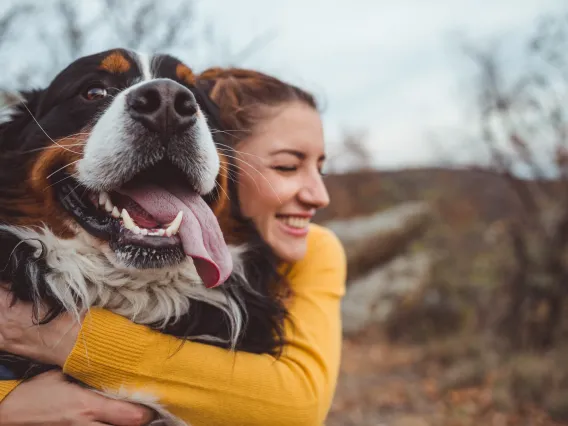Human-Animal Interaction
We house the largest faculty group dedicated to studying how the human-animal relationship can affect the health of animals, humans, and our communities.
Exploring the science behind the human-animal bond
What is Human-Animal Interaction?
Human-Animal Interaction (HAI) refers to any relationship or interaction between a person and a non-human animal. Although people have lived alongside animals for thousands of years, research in Human-Animal Interaction is relatively new. Researchers have only begun looking at the effects of human relationships with other animals [1]. One component of Human-Animal Interaction is the Human-Animal Bond, often defined as a mutually beneficial relationship between people and animals that influences their health and well-being. According to some research, interacting with animals may improve our physical [2] and mental health [3, 4, 5], as well as enhance aspects of our daily lives [6]. Similarly, research has found that Human-Animal Interactions may have positive results for some animals involved, including reduced anxiety and fear [7] and health benefits [8]. However, these findings are not universal, and there remains a need for rigorous scientific research to evaluate the outcomes in greater depth [9].

Human-Animal Interaction encompasses many relationships with animals, including companion animals, emotional support animals, working animals, and any Animal-Assisted Intervention. Animal-Assisted Intervention is an umbrella term for an intervention that purposely incorporates animals into its process. Three branches of Animal-Assisted Intervention include (1) Animal-Assisted Therapy, which is the incorporation of animals as a form of treatment in a goal-directed intervention, (2) Animal-Assisted Activities, which are less structured enrichment activities with animals intended to enhance a participant’s quality of life, and (3) Animal-Assisted Education, which are structured activities meant to enhance a participant’s academic or educational abilities [10, 11].
Also categorized under Animal-Assisted Intervention are Service or Assistance Animals trained to perform specific tasks to aid individuals with disabilities in their day-to-day activities [12]. Service animals differ from therapy animals in that they are prepared to assist one specific person whom they may accompany in public [13]. In contrast, therapy animals offer support for one or multiple people, facilitated by a handler who is not a participant in the intervention.
Despite the advantages of human relationships with animals, not all human-animal interactions are positive [14]. Some species or individual animals are not a good fit for close relationships with humans or participation in Animal-Assisted Intervention. Likewise, some people may find contact with animals unpleasant or be allergic or afraid. Human-Animal Interaction may manifest itself differently across cultures depending on the species of animals involved, varying cultural views towards non-human animals, and familial history of pet ownership [15].
Human-Animal Interactions may benefit one party but not the other, such as in cases where the animal has not been socialized with humans before the interaction and feels stressed or scared. More severe detriments, such as animal abuse, neglect, and animal bites, pose a risk to humans and animals. Therefore, it is essential to acknowledge that not every Human-Animal Interaction is positive, and assessments of the experiences and outcomes of both humans and animals are crucial [16].
At the OHAIRE lab, we look at both positive and negative aspects of Animal-Assisted Intervention and Human-Animal Interaction. Through this process, we hope to obtain a more comprehensive picture of the unique and pervasive interactions between humans and animals. Our goal is to conduct meaningful, clinically relevant research that enhances the interactions and outcomes for both parties.
- McCune, S., Kruger, K. A., Griffin, J. A., Esposito, L., Freund, L. S., Hurley, K. J., & Bures, R. (2014). Evolution of research into the mutual benefits of human–animal interaction. Animal Frontiers, 4(3), 49-58.
- Matchock, R.L. (2015). Pet ownership and physical health. Current Opinion in Psychiatry, 28(5), 386-392.
- Crossman, M. K., Kazdin, A. E., Matijczak, A., Kitt, E. R., & Santos, L. R. (2018). The Influence of interactions with dogs on affect, anxiety, and arousal in children. Journal of Clinical Child & Adolescent Psychology, 1–14.
- Bergen-Cico, D., Smith, Y., Wolford, K., Gooley, C., Hannon, K., Woodruff, R., Spicer, M., & Gump, B. (2018). Dog ownership and training reduces post-traumatic stress symptoms and increases self-compassion among veterans: Results of a longitudinal control study. The Journal of Alternative and Complementary Medicine, 24(12), 1166–1175.
- Kruger, K. A., & Serpell, J. A. (2010). Animal-assisted interventions in mental health: Definitions and theoretical foundations. In A. Fine (Eds.), Handbook on animal-assisted therapy (3rd, pp. 33-48). San Diego: Academic Press.
- Richards, E. A., McDonough, M. H., Edwards, N. E., Lyle, R. M., & Troped, P. J. (2013). Psychosocial and environmental factors associated with dog-walking. International Journal of Health Promotion and Education, 51(4), 198-211.
- Cloutier, S., Panksepp, J., & Newberry, R. C. (2012). Playful handling by caretakers reduces fear of humans in the laboratory rat. Applied Animal Behaviour Science, 140(3-4), 161-171.
- Gourkow, N., Hamon, S. C., & Phillips, C. J. C. (2014). Effect of gentle stroking and vocalization on behaviour, mucosal immunity and upper respiratory disease in anxious shelter cats. Preventive Veterinary Medicine, 117(1), 266-275.
- Vitztum, C., & Urbanik, J. (2016). Assessing the dog: A theoretical analysis of the companion animal’s actions in human-animal interactions. Society & Animals, 24(2), 172-185.
- Fine, A. H., & Mackintosh, T. K. (2015). Animal-assisted interventions: Entering a crossroads of explaining an instinctive bond under the scrutiny of scientific inquiry.In H. Friedman (Eds.), Encyclopedia of Mental Health (2nd, pp. 68-73). Academic Press.
- International Association of Human-Animal Interaction Organizations (IAHAIO), Task Force on the Definitions for Animal-Assisted Intervention and Guidelines for Wellness of Animals Involved. (2014). Report of The IAHAIO Definitions for Animal-Assisted Intervention and Guidelines for Wellness of Animals Involved. Retrieved from: https://iahaio.org/new/index.php?display=declarations
- Parenti, L., Foreman, A., Meade, B. J., & Wirth, O. (2013). A revised taxonomy of assistance animals. Journal of Rehabilitation Research and Development, 50(6), 745-56.
- Americans With Disabilities Act of 1990, 42 U.S.C.A. § 12101 et seq. (West 1993).
- Dhont, K., Hodson, G., Loughnan, S., & Amiot, C. E. (2019). Rethinking human-animal relations: The critical role of social psychology. Group Processes & Intergroup Relations, 22, 769-784.
- Gray, P. B., & Young, S. M. (2011). Human-pet dynamics in cross-cultural perspective. Anthrozoös, 24(1), 17-30.
- Lerner, H. (2019). A proposal for a comprehensive human–animal approach of evaluation for animal-assisted interventions. International Journal of Environmental Research and Public Health, 16(22), 4305.
INVEST IN A HEALTHIER FUTURE
Join our efforts to advance human and animal health globally through financial support.
Human-Animal Interaction Research Areas

OHAIRE LAB
The OHAIRE Group is leading in several new areas of discovery related to human-animal interaction. Our overarching research agenda examines the possible role of human-animal interaction in enhancing human mental health and wellness.

Arizona Canine Cognition Center
The Arizona Canine Cognition Center is a group led by Dr. Evan MacLean focused on studying dog psychology compared to humans, primates, or other animals. Our research is driven by the broad questions of what makes animal minds the way they are, how they got that way, and why.

HAI Faculty Research
The College of Veterinary Medicine is home to dedicated faculty intent on solving critical challenges through research. Learn more about the ongoing diverse work directed by our faculty and staff and how it advances the veterinary medicine and education field.

BRAY Lab
The BRAY lab, led by Dr. Emily Bray, researches the cognitive, behavioral, and early environmental factors that affect later life outcomes in dogs. This research, spanning both pet and working dog populations, asks questions ranging in scope from understanding early maternal style to cognitive aging to how genetics contribute to behavioral traits.

HAB (Human-Animal Bond) Lab
The HAB lab, led by Dr. Kerri Rodriguez, researches the mechanisms, outcomes, and implications of the human-animal bond for human and animal health and well-being. Our research seeks to understand how positive interactions with animals - including those with companion, therapy, facility, and service animals - may lead to therapeutic benefits among vulnerable populations.
HAI Research Series
The series features regular scholarly talks and discussions on various topics surrounding human-animal relationships. Our affiliates investigate different facets of human-animal relationships, broadly construed. Collectively, we have expertise in veterinary medicine, animal cognition, anthropology, interpersonal psychology, and human decision-making, among other disciplines.
